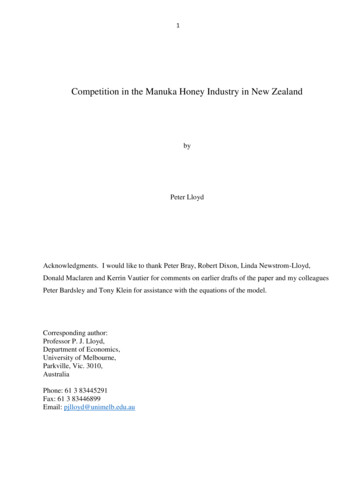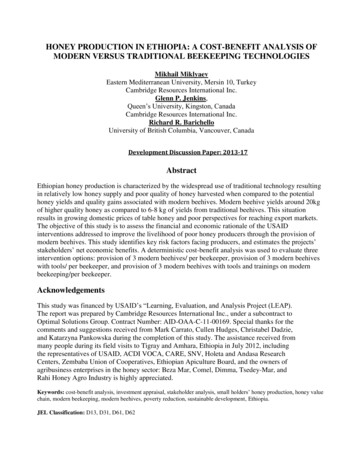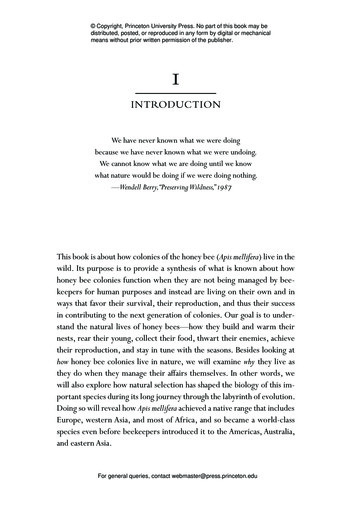
Transcription
1Competition in the Manuka Honey Industry in New ZealandbyPeter LloydAcknowledgments. I would like to thank Peter Bray, Robert Dixon, Linda Newstrom-Lloyd,Donald Maclaren and Kerrin Vautier for comments on earlier drafts of the paper and my colleaguesPeter Bardsley and Tony Klein for assistance with the equations of the model.Corresponding author:Professor P. J. Lloyd,Department of Economics,University of Melbourne,Parkville, Vic. 3010,AustraliaPhone: 61 3 83445291Fax: 61 3 83446899Email: pjlloyd@unimelb.edu.au
2AbstractThis paper examines the problems of spatial competition in the beekeeping segment of the NewZealand manuka honey industry. Competition between two close apiaries results in negativereciprocal production externalities. A basic geometric model of spatial competition between twoapiaries is developed. Various forms of possible management and regulation of the industry areexplored, drawing on the experience of management and regulation of production activities withsimilar externality problems, particularly oil and gas reservoirs, and New Zealand competitionpolicy.Key words: manuka honey, spatial competition, production externalities, regulation
3Competition in the Manuka Honey Industry1. Introduction and Brief Profile of the IndustryAs manuka honey1 production in New Zealand has expanded very rapidly in the last sevenyears or so, a number of economic problems have emerged. These include the problem ofsetting product standards in the industry and adulteration, and that of protecting consumersfrom false or unsupported claims of medical benefits from the use of manuka honey.Consumer doubts about the quality of manuka honey products and their health benefitsthreaten the reputation of the industry. The New Zealand industry is also concerned about theuse of the generic name of “manuka” honey (called the “geographical indication” in WTOtrade law) in Australia. Another substantial problem is the unregulated aggressivecompetition among beekeepers for access to the limited stock of manuka bush hive sites.In early 2017, the Ministry for Primary Industries released a ‘scientific’ definition of manukahoney as a part of its consultation with the industry to develop product standards (Ministryfor Primary Industries, 2017c) and proposed new export requirements for all bee products(Ministry for Primary Industries, 2017d). Claims of medical or health benefit are a matter forseparate government regulation through product standards and consumer protection law. InAugust 2017, New Zealand honey producers announced they had applied for exclusivetrademarks on “manuka honey” in the major countries buying the honey in world markets,including Australia. By contrast, aggressive competition among beekeepers seems to havereceived little attention. It is an interesting problem in the economics of regulation andcompetition policy.The manuka honey industry is a part of the honey industry.2 Manuka honey sells at the topend of the market for honey types. It is marketed as an anti-bacterial agent and health food.The price for bulk manuka honey, which is the price paid to the beekeepers, is on averageseveral times that of the prices paid to beekeepers producing other honey types (Ministry forPrimary Industries, 20171, Table 5). Prices per kilogram for bulk manuka honey ranged from 12 up to 148.00 in 2016. Retail prices also range very widely, depending on the rating ofthe product and to a much lesser extent on the quantity purchased. For the highest ratedproducts, that is, pure manuka honey,3 retail prices range up to just over 1,000 perkilogram. With a wide gap between bulk and retail prices for manuka honey, large profitshave been made by honey processors and packers downstream of the beekeeping operation,
4selling both on the New Zealand market and exporting. This paper deals only with theupstream beekeeping sector of the manuka honey industry.4As a consequence of the rapid increase in international demand for manuka honey, especiallyin China, the bulk price for manuka honey has more than doubled in the last five years(Ministry for Primary Industries, 2017a, Table 1). Along with this, the volume of productionof manuka honey has soared. Together these trends have made the industry very profitable.Fortunes are being made by the incumbents in the industry.This in turn has attracted many new entrants into the industry. Some of them wereestablished beekeepers who previously harvested only non-manuka honey types and some ofthem entrants into beekeeping. Foreign investors have entered the industry. Corporateenterprises, which are much larger than the industry average in terms of hive numbers, areincreasing their share of the manuka honey production. Areas of manuka bush not previouslyharvested have been opened up; the Department of Conservation have greatly increasedconcessions on the Public Conservation Lands which it manages and Iwi production is beingencouraged by Maori groups and the government. The Ministry for Primary Industries isworking with the industry to trial manuka plantations in order to supplement wild harvestingfrom natural manuka blocks. It is hoped that large-scale high-performance science-basedplantations will boost aggregate national output. The Ministry has said that the value of theNew Zealand manuka honey industry could grow from an estimated 75 million in 2010towards 1.2 billion per year (Ministry for Primary Industries, 2017b). New cultivars arebeing developed to increase hive yields.As a consequence of these trends, manuka honey apiary5 and hive numbers and annualproduction of manuka honey have all grown rapidly. Unfortunately, the statistics of apiaryand hive numbers and annual production (Ministry for Primary Industries, 2017) cannotprovide a breakdown of the totals for the manuka honey type alone because of the lack in thepast of a consistent definition of manuka honey; sales of ‘manuka’ in New Zealand are salesof both the manuka and the kanuka species of tea tree as both are commonly called ‘manuka’,and sales of both manuka and kanuka honey vary in their purity. Consequently, there are notime series of annual production of manuka honey in New Zealand. Wikipedia (2017) gives afigure of 1,700 tonnes of manuka honey produced in New Zealand but this is only a roughcalculation6and other industry sources give a figure of around 3,000 tonnes when kanukahoney is included.7 (The total for all honey types was 19,885 tonnes in 2016.)
5This paper provides an overview of the beekeeping sector of the manuka honey industry. Itfocuses on the nature of competition among beekeepers. The form of competition leads toinefficient production as well as conflict between beekeepers. Later sections of the paperexamine the possibilities of management or regulation of the industry to resolve competitionissues and to improve the efficiency of production in this industry.2. Competition among BeekeepersCompetition in the beekeeping segment of the industry takes the form mainly of competitionfor hive sites. Given that the stock of manuka bush is fixed in the short run (which can beequated with one summer honey season), competition among beekeepers for hive sites hasincreased with the growth in apiary numbers. (There is also competition for wintering sites.)Apiary rentals for manuka sites have increased rapidly in the last two years and in 2016 rentalfees were up to 1,000 per apiary (Ministry for Primary Industries, 2017a, Table 7). As anillegal form of competition, there have been instances of the poisoning and sabotaging andstealing of hives (Ministry for Primary Industries, 2017a, p. 12). There is growing concernthat the increase in apiary and hive numbers may also reduce the aggregate production by allhives in some areas (see Newstrom-Lloyd, 2015 and McPherson, 2016 and 2017).These problems arise because of the nature of the industry. It is one in which there is freeentry because there are no entry barriers in the form of large scale or complex technologyrequired for production and there is no government limitation on entry into the industry. Theofficial statistics for 2016 show that there were 6,735 registered8 beekeeping enterprises. Ofthese many were hobby farmers (defined as enterprises with up to 50 hives). At the other endof the distribution of enterprises by hive numbers, 29 were classified as “mega commercial”enterprises (defined as enterprises with more than 3,000 hives each). The largest of these hadover 30,000 hives and in the aggregate mega commercial enterprises managed 34 per cent ofall registered hives.Commercial enterprises have many apiaries and their apiaries each have many hives. Longterm commercial beekeepers know by trial and error over a number of years how many hivesin one apiary will give them the best return for the apiary. This number varies from site tosite, depending on the climate and the floristic resources of the location (Newstrom-Lloyd,2015 and Department of Conservation, 2015, p.11). The national average for all apiaries andall types of honey is around 15 hives per apiary (Ministry for Primary Industries, 2017a,Table 4)
6Moreover - and this is the central point - the production of one beekeeper affects theproduction of other beekeepers in the neighbourhood. For this purpose the neighbourhood ofone apiary may be defined as the area surrounding the site which is visited by bees fromhives on the site. The foraging range of bees is around three to five kilometres from thehive9. Customarily in New Zealand, beekeepers observed the rule that they would not locateapiaries of new hives within three kilometres of existing hives. In the recent past thisdistance was reduced to two kilometres. This custom has broken down and as a consequencethere is an overlap between the foraging areas of some apiaries.Interaction among beekeepers is a production externality. A production externality ariseswhen one producer’s activities affect other producers in a way or ways which do not operatethrough the market. A standard textbook example of production externalities are the effectsof a steel mill releasing pollutants into a stream, which reduces the output of downstreamfisheries. Most production externalities are negative, that is, the output of one producerreduces the output of another or others. This is true too of the manuka honey beekeeperproblem in which a new entrant into the industry located within a few kilometres of anincumbent reduces the annual output of the incumbent.3. Analysis of Production ExternalitiesEach externality problem is different because each has its own unique characteristics of thegeneration of the externality and the ways it affects other producers. Positive productionexternalities, in which the production activities of one producer have a positive effect on theoutput of one or more other producers, are rare. By a surprising coincidence, the standardexample is actually from the bee industry again. This is the case of a beekeeper and anorchardist, made famous in the literature of economics by James Meade (1952).10 It yields adouble reciprocal positive externality: the orchardist has a positive effect on the beekeeperbecause his flowering fruit trees provide nectar and pollen for the bees and the beekeeper hasa positive effect on the orchardist because his bees pollinate the fruit trees.This beekeeper-orchardist case has attracted a large literature, mainly in the USA. The thrustof this literature is that the externality has been captured or “internalized” by the emergenceof well-organized markets for pollination services (see the classic article by Cheung, 1973and the recent survey by Rucker, Thurman and Burgett, 2014).The manuka honey problem is a different problem. It involves a negative externality fromthe close proximity of two (or more) apiaries operated by two (or more) beekeepers. Usually
7the reporting of this case points to the entrant beekeeper who sets up a new apiary with noregard to the effects of bees in his apiary on the output of bees in a neighbouring apiary orapiaries.Competition between any two (or more) neighbouring apiaries of bees is a case of spatialcompetition. The competition can be illustrated by some geometry.4. The Geometry of Spatial Competition between ApiariesTo analyse competition among two (or more) beekeepers, one needs a model of competitionbased on the harvesting area of an apiary. The analysis of this competition is an exercise inEuclidean geometry.Begin with a single isolated apiary of bees, located at a point L1. The harvesting area is acircle whose radius is determined by the maximum distance that bees forage from the hives inthe apiary. In reality this radius is not fixed as it will depend on the supply of nectar andpollen available, the weather and other factors. However, we may take it as an average over aperiod of time and therefore fixed. Further, the radius of the circle may be taken to be unitywithout any loss of generality. Consequently the area of the circle is π.We will take this tobe the apiary of one beekeeper called Beekeeper 1.Now consider that a second beekeeper, Beekeeper 2, establishes a new apiary in theneighbourhood. This is located at the point L2. The two apiaries are sufficiently close thatthe harvesting areas overlap. This situation is depicted in Figure 1. The circle depicting theharvesting area of Beekeeper 2 is identical to that of Beekeeper 1 (i.e. it has the same radiusand hence the same area). The area A is the intersection of the set of points within the twocircles. It is the area of competition between the bees of the two beekeepers. This area maybe expressed as a fraction of the area of the circle of Beekeeper 1, c A/π.Within the area of competition bees from the hives of the two beekeepers compete for thesupply of pollen and nectar. The main negative externality effect of this competition is toreduce the actual manuka honey collection of Beekeeper 1 below the potential honeycollections that exists within the radius of the circle if there is no competitor. A secondnegative effect is that the bees in the apiary have less food which compromises the colonyreproduction and increases the risk of pests and diseases and of robbing between hives. Insevere cases, this may result in the loss of colonies (hives).11 These effects from thecloseness of apiaries are known as “overcrowding”. From the point of view of efficient
8production, overcrowdding has the effect of increasing unit costs and may reduce aggregateoutput (Newstrom-Lloyd, 2016 and McPherson, 2017).There is a second source of putting too many bees in a given area for efficient production,namely “overstocking”. Overstocking is putting too many hives in one apiary. (Brown et al,forthcoming). This results in reducing the output of each hive and, like overstocking, mayincrease the risks of diseases, pests and colony loss. However, the reduced hive productionaffects mainly the beekeeper who overstocks rather than the neighbouring beekeeper. It isdue to the inexperience of new beekeepers. Hence, the variable of the number of hives in anapiary is not included in the subsequent analysis.While this competition has been viewed from the point of view of the first beekeeper, itshould be noted that the area of competition applies equally to the second beekeeper. Theproximity of two apiaries means that the hives of Beekeeper 1 lower the harvest of Beekeeper2’s bees and at the same time the hives of Beekeeper 2 lower the harvest of Beekeeper 1’sbees. Thus, it is an example of a double reciprocal production externality where bothproduction externalities are negative. This is the first example of a double negativeproduction externality in the literature on externalities to my knowledge. Moreover, thereciprocal externalities are symmetric, that is, both beekeepers share the same area ofcompetition.and their production is affected in the same way.12Competition between two (or more) beekeepers also poses a societal problem. The social oreconomy-wide objective in this analysis is efficient production. This involves maximising thevalue of honey production net of production costs. In the case of this industry there is no needto add a concern over possible effects of competition among beekeepers on consumer prices.The beekeeping segment of the industry is fiercely competitive and individual beekeepershave no market power. Moreover, the price received by the beekeepers is a small fraction ofthe consumer price charged downstream. Any concern over overpricing to consumers shouldbe addressed at the retail stage.To achieve this objective of efficient production, there will be an optimal location of apiaries.A sub-optimal location will result in overcrowding, which will increase unit costs and mayreduce aggregate output.When the location of two neighbouring apiaries is fixed, the area of competition is fixed. Ifthe two apiaries were to move closer together, the area of the intersection of the two circleswould increase. However, the relationship between the distance between the two apiaries, the
9separation distance, on the one hand and the area of competition on the other is not a simplelinear relationship. The precise relationship is derived in the Appendix and it is given by thefunction in Equation (2).This function relating the separation distance to the area of competition is essential tounderstanding competition in the manuka honey beekeeping industry. It is also essential tothe societal problem of locating apiaries so as to maximise the net value of honey productionfrom a given area of manuka bush. (See Appendix for further discussion).Besides beekeepers, there is another set of economic agents who play an essential role indetermining the nature of competition in the manuka honey industry. These are thelandowners who must grant permission for an apiary of hives to be located on their landwhen the honey producer is not the landowner. The right to locate hives at a location onhis/her land is sold for a price, typically for one honey season, under a Land Use Agreement.Hive rentals in the industry are based on a fixed price per hive or a percentage of the crop or acombination of both.Landowners too have sought to increase their income from hive rentals as the profits frommanuka honey beekeeping have risen rapidly. Land Use Agreements reached between thelandowners and the beekeepers will decide the extent of competition in the industry,including the areas of competition which give rise to conflict and overcrowding. Somelandowners are known to have invited more than one beekeeper to put hives on their land. Insuch cases a landowner has an incentive to maximise the aggregate net production from theland as this will maximise their own hive rental income. Mistakes have been made inallowing overcrowding on the land of one landowner due to inexperience but such mistakeswill tend to be corrected in the self-interest of the landowner. When a manuka bush stand canbe accessed from the land of more than one landowner, however, the danger of overcrowdingwill persist.5. Management or Regulation of Production Externality SituationsWhat I am calling the manuka honey competition problem has not received attention fromeconomists in New Zealand or elsewhere to my knowledge. The last Apiculture MonitoringProgramme report recognises the problem: “Tension between neighbouring beekeepersand/or landowners has in some cases led to hive theft and vandalism.” It then adds“Regulatory controls are being promoted by some, but industry, local and centralgovernments recognise the legal and practical challenges of implementing and policing
10regulatory controls over apiary site placement.” (Ministry for Primary Industries, 2017a, p.12).The manuka honey problem is a very different problem to the bee pollination externalityproblem which has received so much attention in the economics literature. The central issuein the manuka honey industry is how to manage or regulate the industry so that competitionbetween neighbouring apiaries operated by different beekeepers is fair and the aggregatevalue of production of manuka honey from a given area of bush is maximised.This manuka honey production problem is an example from the family of externalities knownas the Problem of the Commons. This includes many well-known externalities such asanimal grazing on Commons land, fisheries, water basins, irrigation schemes, oil and gasreservoirs, and climate change. All of these externalities arise because agents have access tocommon resources. In each problem a non-cooperative market solution is inefficient, that isthere is a market failure.Elinor Ostrom has analysed governance issues in common pool resources, especiallyirrigation systems and fisheries.13 Her analyses show that government regulation in anattempt to improve efficiency usually does not produce an efficient solution and may beworse that the market solution. This is sometimes called government failure. Moreover, heranalyses show that left to themselves the market operators on the commons in some casesproduce a voluntary cooperative solution that eliminates conflict and leads to an efficientoutcome. (See the survey by Aligica and Sterpan, 2017.) The foremost condition required forthe emergence of a voluntary cooperative community solution is closed access, the ability tocontrol access to the common resource (Ostrom, Chang, Pennington, and Tarko, 2012).The manuka honey production problem has most similarity to one well-explored case of theProblem of the Commons, namely, that of production by multiple operators on a common(sub-surface) oil reservoir. In each case, competition occurs over a well-defined area. An oilreservoir is like a block of manuka bush. Several beekeepers may have access to this stand,just as several operators have access to a common oil reservoir; they share a commonresource. Moreover, in the case of both an oil reservoir and manuka bush stand, access to thecommon resources is controlled by owners of the land.Management and regulation of oil reservoirs has received huge attention, chiefly in the USAwhere the rights to extract oil (or gas) underground are held by the surface landowners or byleasors who have acquired the rights from the landowners. This is known as the ‘rule of
11capture’; the situation in which ‘the owner of a tract of land acquires title to the oil and gaswhich he produces from wells drilled thereon, though it may be proved that part of such oil orgas migrated from adjoining lands’ (quoted in Kenyon, 2014, p. 2). US Courts have upheldthis rule. Kenyon (2014, p.2) notesOne effect of this ruling, among others, was the creation of a highly competitivepractice of drilling in the US, with each landowner drilling as many wells on his land aspossible in order to ensure maximum production from his part of the field, even goingso far as to drill on the very edge of the lease line in the hope of extracting oil or gaswhich may have migrated from his or her neighbour’s land.This literature noted the inefficiency of competitive market access to a reservoir. Each of theproducing firms has an incentive to maximise the economic value of its own lease rather thanthat of the reservoir as a whole. A competitive or non-cooperative outcome results in severalinefficiencies. There may be too many wells resulting in excessive capital costs, wells maybe located in the wrong places and the aggregate value of oil produced may be less than themaximum possible.This oil reservoir case is of interest to analysts of the manuka honey problem. There is amarket for access to manuka bush as beekeepers pay farmers and other landowners for theright to locate hives on their land, just as there is a very well developed market for land andleases on an area covered by an oil reservoir. As noted above, the unregulated market formanuka sites results, in some sites, in overcrowding of hives and excess costs and it mayresult in an aggregate output less than the maximum possible, as in the oil reservoirexternality problem.Our chief interest in the oil reservoir problem is in the remedies to the problem of inefficientproduction which have developed in the oil reservoir case. One remedy in the situation of oilreservoirs is unitisation. ‘With unitisation, a single firm, often with the largest leased area, isdesignated as the unit operator to develop the field as a whole.’ (Libecap, forthcoming). Theunit operator has an incentive to maximise the output of the whole reservoir, with theindividual rights holders sharing in the net profits of the field on an agreed formula.Unitisation makes optimal well placement and production possible. It is another example ofa voluntary cooperative solution to the Problem of the Commons. In practice, there aredifficulties due to the imperfect and uncertain knowledge of the properties of the field and the
12consequential difficulty of negotiating a unit agreement (Libecap, forthcoming and referencestherein). For this reason only a small fraction of reservoirs are managed by a unit manager.A related remedy is for one operator to buy out all others. The negotiation of an agreedpurchase price for each of the other leases faces the same valuation problems as that ofnegotiating a unit agreement.Another possible remedy is government regulation. The markets for oil and gas are highlyregulated in some countries.6. Applying the Analysis to the Management or Regulation of Manuka HoneyProductionShould the manuka honey industry be self-managed by the industry or regulated by thegovernment?The status quo is no regulation of the beekeeping industry. It allows any beekeeper toestablish hives wherever it wishes. The market for hive site services then determines freelythe location of hives and manuka honey production. (Legal remedies for sabotage andpoisoning or interfering with the hives of other beekeepers remain, as do regulations relatingto bee health and biosecurity).In the case of manuka honey production, a voluntary solution by the industry itself throughunitisation does not seem feasible in general. The chief difficulty is that the Ostromcondition of closed access is not met. There are typically many possible locations for hivesinside and outside a manuka block on parcels of land owned by different landowners and thenumber and location of hive sites changes over time as beekeepers sign new agreements withlandowners.There is, however, an exception. Manuka stands on Crown land or Maori landoffer the possibility of a unitised operation. Similarly, if large scale manuka plantations arecreated in the future, they would have a unitised operation. At the present time, large singleownership stands account for only a small part of total manuka honey production.The next possibility is self-regulation by the industry. This could be by means of a code ofconduct. A code could include a separation rule and other rules. Apiculture New Zealand,the peak bodies for the beekeeping industry since it began in April 2016, has recentlydeveloped a Beekeeper Code of Practice (Apiculture New Zealand, 2017). Clause 1.8 of theCode requires that members of the Association ‘ respect appropriate distances betweenhis/her hives and another beekeeper’s hives’. What distance is ‘appropriate’ is not specified.
13A precise rule could specify the minimum distance between apiaries. With the knowledge ofthe relationship between the separation distance and the area of competition, the separationdistance could be fixed so as to restrict the area of competition to some pre-set limit. Forexample, it might be decided that a new apiary must be located such that the area ofcompetition is no more than a fixed percentage of the area of an established apiary. Ifcompetition conforms to the basic model in the Appendix, Equation (2) tells us that therelationship between the separation distance on the one hand and the area of competition onthe other. Suppose we set the limit of overlap at no more than, say, 20 per cent of the area ofan established apiary. Then, from this equation, the proximity distance (p) can be no morethan 32 per cent of the distance between the established apiary and point of location of thesecond apiary which would produce zero competition between the two apiaries. (See Figure2.). Hence, the separation distance (d 1-p) must be at least 68 per cent of this distance Ifthe bee harvesting distance is set at, say, three kilometres, this distance is 6 kilometres. Thatis, the two apiaries must be at least 4.08 ( 0.68x6) or roughly 4 kilometre apart if the area ofcompetition is to be no more than 20 per cent of the harvesting area of the established apiary.As a part of its management of Public Conservation Land, the Department of Conservation(2015, p.11) assumes a foraging distance of 3km but it imposes a 6 km exclusion zonebetween apiaries. This rule results in zero competition between two neighbouring apiaries,which is very conservative14.One difficulty with a separation rule is that it gives priority to the incumbent producers.While this is the effect of the traditional customary separation rule, and seems to be a rulefavoured by many in the industry today, protection of incumbents may lead to higher costproduction and is inequitable. Moreover, the ease of entry and the past history of theindustry suggest that a code will not be fully effective. Experience with self-regulation inother industries indicates that, when the conditions for a voluntary cooperative solution arenot met, for some prducers, the profit incentives for producers will override consideration ofcollective benefits.Since the passage of the Commerce Act 1986, the New Zealand approach to industryregulation has been to avoid regulation of an industry and to deal with competition problemsin an industry by reference to competition law if and when they occur. (The exceptions are ahandful of industries which present problems from the point of view of competition due tothe presence of networks or other specia
honey is included.7 (The total for all honey types was 19,885 tonnes in 2016.) 5 This paper provides an overview of the beekeeping sector of the manuka honey industry. It . of a steel mill releasing pollutants into a stream, which reduces the output of downstream fisheries. Most production externalities are negative, that is, the output of .










